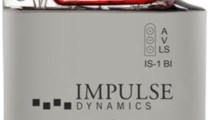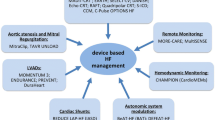Abstract
Heart failure with reduced ejection fraction (HFrEF) represents a significant public health burden associated with incremental health care costs. Given the limitations associated with pharmacological autonomic regulation therapy (ART), device-based autonomic neuromodulation is on the horizon now for ART in those patients. This systematic review aimed primarily to determine the effect of ART by devices on functional status and quality of life (QOL) in patients with HFrEF. We performed a meta-analysis of five randomized controlled trials (1074 patients) comparing ART by devices versus optimal medical therapy (OMT) in HFrEF. We assessed pooled estimates of odds ratio (OR) for improvement in New York Heart Association (NYHA) class and mean differences (MD) in 6-minute hall walk distance (6-MHWD), Minnesota Living with Heart Failure Questionnaire (MLHFQ) score, N-terminal pro b-type natriuretic peptide (NT-proBNP) levels, and left ventricular end-systolic volume index (LVESVi) with their 95% confidence intervals (CIs) at 6-month follow-up. Compared to OMT alone, ART by devices in HFrEF significantly improves NYHA class (OR 2.26, 95% CI 1.33 to 3.83, P = 0.003), increases 6-MHWD (MD 45.53 m, 95% CI 30.61 to 60.45, P < 0.00001), improves MLHFQ score (MD − 10.59, 95% CI − 20.62 to − 0.57, P = 0.04) with neutral effect on NT-proBNP levels (MD − 236.5 pg/ml, 95% CI − 523.86 to 50.87, P = 0.11) and LVESVi (MD − 1.01 ml/m2, 95% CI − 4.49 to 2.47, P = 0.57). We concluded that device-based neuromodulation therapy significantly improves functional status and quality of life in patients with HFrEF.




Similar content being viewed by others
Abbreviations
- 6-MHWD:
-
6-minute hall walk distance
- ART:
-
Autonomic regulation therapy
- CI:
-
Confidence interval
- HFrEF:
-
Heart failure with reduced ejection fraction
- LVESVi:
-
Left ventricular end-systolic volume index
- MD:
-
Mean difference
- MLHFQ:
-
Minnesota Living with Heart Failure Questionnaire
- NT-proBNP:
-
N-terminal pro b-type natriuretic peptide
- NYHA:
-
New York Heart Association
- QOL:
-
Quality of life
References
Ambrosy A, Gheorghiade M, Chioncel O, Mentz R, Butler J (2014) Global perspectives in hospitalized heart failure: regional and ethnic variation in patient characteristics, management, and outcomes. Curr Heart Fail Rep 11:416–427. https://doi.org/10.1007/s11897-014-0221-9
Roger V, Weston S, Redfield M, Hellermann-Homan J, Killian J, Yawn B, Jacobsen SJ (2004) Trends in heart failure incidence and survival in a community-based population. JAMA 292:344–350. https://doi.org/10.1001/jama.292.3.344
Pepper G, Lee R (1999) Sympathetic activation in heart failure and its treatment with beta-blockade. Arch Intern Med 159:225–234. https://doi.org/10.1001/archinte.159.3.225
Hogg K, McMurray J (2005) Neurohumoral pathways in heart failure with preserved systolic function. Prog Cardiovasc Dis 47:357–366. https://doi.org/10.1016/j.pcad.2005.02.001
Regitz V, Leuchs B, Bossaller C, Sehested J, Rappolder M, Fleck E (1991) Myocardial catecholamine concentrations in dilated cardiomyopathy and heart failure of different origins. Eur Heart J 12(Suppl D):171–174. https://doi.org/10.1093/eurheartj/12.suppl_D.171
Olshansky B, Sabbah H, Hauptman P, Colucci W (2008) Parasympathetic nervous system and heart failure: pathophysiology and potential implications for therapy. Circulation 118:863–871. https://doi.org/10.1161/CIRCULATIONAHA.107.760405
Dunlap M, Bibevski S, Rosenberry T, Ernsberger P (2003) Mechanisms of altered vagal control in heart failure: influence of muscarinic receptors and acetylcholinesterase activity. Am J Physiol Heart Circ Physiol 285:H1632–H1640. https://doi.org/10.1152/ajpheart.01051.2002
Triposkiadis F, Karayannis G, Giamouzis G, Skoularigis J, Louridas G, Butler J (2009) The sympathetic nervous system in heart failure physiology, pathophysiology, and clinical implications. J Am Coll Cardiol 54:1747–1762. https://doi.org/10.1016/j.jacc.2009.05.015
Bristow M (2003) Antiadrenergic therapy of chronic heart failure: surprises and new opportunities. Circulation 107:1100–1102. https://doi.org/10.1161/01.CIR.0000054530.87613.36
Chatterjee N, Singh J (2015) Novel interventional therapies to modulate the autonomic tone in heart failure. J Am Coll Cardiol HF 3:786–802. https://doi.org/10.1016/j.jchf.2015.05.008
Joe V, Adrian F, Cheryl L, Lisa S. The Role of Patient-Centered Outcomes Research in the Current Healthcare Landscape: Setting the Stage Available at: https://www.medscape.org/viewarticle/851807 (Accessed February 2018)
Moher D, Liberati A, Tetzlaff J, Prisma Group (2009) Preferred reporting items for systematic reviews and meta-analyses: the PRISMA statement. PLoS Med 6:e1000097. https://doi.org/10.1371/journal.pmed.1000097
Bendary A, Bendary M, Salem M. Autonomic regulation device therapy in heart failure with reduced ejection fraction; a systematic review and meta-analysis of randomized controlled trials. PROSPERO 2018 CRD 42018085931. Available at:http://wwwcrdyorkacuk/PROSPERO/display_recordphp?ID=CRD42018085931 (Accessed March 2018)
Higgins J, Thompson S, Deeks J, Altman D (2002) Statistical heterogeneity in systematic reviews of clinical trials: a critical appraisal of guidelines and practice. J Health Serv Res Policy 7:51–61. https://doi.org/10.1258/1355819021927674
DerSimonian R, Laird N (1986) Meta-analysis in clinical trials. Control Clin Trials 7:177–188. https://doi.org/10.1016/0197-2456(86)90046-2
Zipes D, Neuzil P, Theres H, Caraway D, Mann D, Mannheimer C, van Buren P, Linde C, Linderoth B, Kueffer F, Sarazin SA, DeJongste M, DEFEAT-HF Trial Investigators (2016) Determining the feasibility of spinal cord neuromodulation for the treatment of chronic systolic heart failure: the DEFEAT-HF study. J Am Coll Cardiol HF 4:129–136. https://doi.org/10.1016/j.jchf.2015.10.006
Abraham W, Zile M, Weaver F, Butter C, Ducharme A, Halbach M et al (2015) Baroreflex activation therapy for the treatment of heart failure with a reduced ejection fraction. J Am Coll Cardiol HF 3:487–496. https://doi.org/10.1016/j.jchf.2015.02.006
Furukawa T, Barbui C, Cipriani A, Brambilla P, Watanabe N (2006) Imputing missing standard deviations in meta-analyses can provide accurate results. J Clin Epidemiol 59:7–10. https://doi.org/10.1016/j.jclinepi.2005.06.006
Hozo S, Djulbegovic B, Hozo I (2005) Estimating the mean and variance from the median, range, and the size of a sample. BMC Med Res Methodol 5:13. https://doi.org/10.1186/1471-2288-5-13
Wan X, Wang W, Liu J, Tong T (2014) Estimating the sample mean and standard deviation from the sample size, median, range and/or interquartile range. BMC Med Res Methodol 14:135. https://doi.org/10.1186/1471-2288-14-135
Higgins J, Thompson S, Deeks J, Altman DG (2003) Measuring inconsistency in meta-analyses. BMJ: British Med J 327:557–560. https://doi.org/10.1136/bmj.327.7414.557
Zannad F, De Ferrari G, Tuinenburg A, Wright D, Brugada J, Butter C et al (2014) Chronic vagal stimulation for the treatment of low ejection fraction heart failure: results of the NEural Cardiac TherApy foR Heart Failure (NECTAR-HF) randomized controlled trial. Eur Heart J 36:425–433. https://doi.org/10.1093/eurheartj/ehu345
Gold M, Van Veldhuisen D, Hauptman P, Borggrefe M, Kubo S, Lieberman R et al (2016) Vagus nerve stimulation for the treatment of heart failure: the INOVATE-HF trial. J Am Coll Cardiol 68:149–158. https://doi.org/10.1016/j.jacc.2016.03.525
Chen W, Ling Z, Xu Y, Liu Z, Su L, Du H et al (2017) Preliminary effects of renal denervation with saline irrigated catheter on cardiac systolic function in patients with heart failure: a prospective, randomized, controlled, pilot study. Catheter Cardiovasc Interv 89(4):E153–E161. https://doi.org/10.1002/ccd.26475
Abdulla J, Køber L, Torp-Pedersen C (2004) Methods of assessing the functional status of patients with left ventricular systolic dysfunction in interventional studies: can brain natriuretic peptide measurement be used as surrogate for the traditional methods? Cardiovasc Drugs Ther 18:219–224. https://doi.org/10.1023/B:CARD.0000033643.93393.46
Savarese G, Orsini N, Hage C, Vedin O, Cosentino F, Rosano G et al (2018) Utilizing NT-proBNP for eligibility and enrichment in trials in HFpEF, HFmrEF, and HFrEF. J Am Coll Cardiol HF 6:246–256
Piña IL, Udelson JE Seeking a clear signal: what are the best surrogates to use in heart failure trials? Available at: https://www.medscape.com/viewarticle/889682# vp_3 (Accessed February 2018)
Verhaert D, Grimm R, Puntawangkoon C, Wolski K, Wilkoff B, Starling R et al (2010) Long-term reverse remodeling with cardiac resynchronization therapy results of extended echocardiographic follow-up. J Am Coll Cardiol 55:1788–1795. https://doi.org/10.1016/j.jacc.2010.01.022
Ioannidis J, Patsopoulos N, Rothstein H (2008) Research methodology: reasons or excuses for avoiding meta-analysis in forest plots. BMJ: Br Med J 336:1413–1415. https://doi.org/10.1136/bmj.a117
Renda G, Ricci F, Giugliano R, De Caterina R (2017) Non–vitamin K antagonist oral anticoagulants in patients with atrial fibrillation and valvular heart disease. J Am Coll Cardiol 69:1363–1371. https://doi.org/10.1016/j.jacc.2016.12.038
Hicks T, Stewart F, Eisinga A (2016) NOACs versus warfarin for stroke prevention in patients with AF: a systematic review and meta-analysis. Open Heart 3(1):e000279. https://doi.org/10.1136/openhrt-2015-000279
McMurray J, Packer M, Desai A, Gong J, Lefkowitz M, Rizkala A, Rouleau JL, Shi VC, Solomon SD, Swedberg K, Zile MR, PARADIGM-HF Investigators and Committees (2014) Angiotensin–neprilysin inhibition versus enalapril in heart failure. N Engl J Med 371:993–1004. https://doi.org/10.1056/NEJMoa1409077
Zipes D, Neuzil P, Theres H, Caraway D, Mann D, Mannheimer C et al (2018) Correction. J Am Coll Cardiol HF 6. https://doi.org/10.1016/j.jchf.2018.05.001
Acknowledgments
We acknowledge the investigators of the DEFEAT-HF study for providing a corrected figure of NT-proBNP data after they were notified about the erroneous plot in their original published work. A correction has been published by the investigators to reflect this change [33].
Author information
Authors and Affiliations
Corresponding author
Ethics declarations
Conflicts of interest
The authors declare that they have no conflict of interest.
Rights and permissions
About this article
Cite this article
Bendary, A., Bendary, M. & Salem, M. Autonomic regulation device therapy in heart failure with reduced ejection fraction: a systematic review and meta-analysis of randomized controlled trials. Heart Fail Rev 24, 245–254 (2019). https://doi.org/10.1007/s10741-018-9745-5
Published:
Issue Date:
DOI: https://doi.org/10.1007/s10741-018-9745-5




